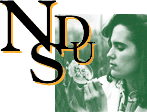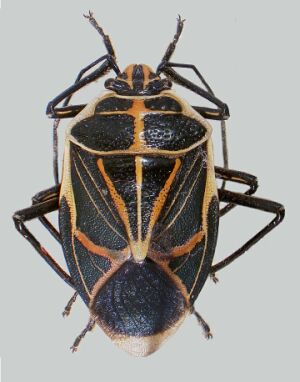 |
|
|
Madates limbatus (Fabricius, 1803) |
|
|
|
Cimex limbatus Fabricius, 1803: 176. Strachia limbata: Spinola, 1837: 320. Pentatoma limbata: Westwood, 1837: 8. Cinxia limbata: Stål, 1862: 105. Madates limbatus: China, 1928: 190. Distribution: Type Material: ST(S), Indonesia, Sumatra, ZMUC.
|
Description of type: Head triangular in front of eyes, lateral jugal margins slightly sinuous, thinly but distinctly reflexed, reflexion slightly broader near apex. Eyes substylate, with a shallow, but distinct sulcus surrounding base of stalk; ocelli somewhat distant from eyes, about 6 times their diameter from adjacent eye. Tylus slightly longer than juga, but apices of juga appear to merge over the top of the distal end of the tylus, but they are not contiguous. Vertex slightly tumose, with a few fine transverse wrinkles and a few weak punctures; surface of rest of head rather flat, becoming obliquely angled upwards near apical lateral margins, completely void of punctures, but having numerous, distinct, transverse wrinkles, those towards apex at an angle proceeding anterioly near lateral margins. Dorsal head coloration yellowish orange except following areas black: a broad longitudinal line including the tylus, the inner margins of the juga (except the apices), and the medial portion of the vertex; a somewhat oblong triangular spot on the basal lateral margin of each juga, each of which proceeds onto the dorsal surface of the adjacent antennifer; the entire dorsal surface of the eye stalks running at an angle towards base of head, but just including each ocellus; the entire basal margin of the head. Antennae entirely black, segment 1 reaching or slightly surpassing apex of head, nearly glabrous, segment 2 with a few short hairs, segments 3-5 somewhat more thickly clothed with short appressed hairs. Anterior pronotal margin arcuately excised to receive head, margin straight medially, entire margin thickly reflexed with sharp suture-like line separating it from rest of pronotum; lateral pronotal margins straight, also thickly and obtusely reflexed, anteriorly overlapping anterior reflexion; each anterior angle with small laterally projecting tooth. Posterolateral margins and posterior margin continuous, gently arcuate, not reflexed. All margins yellow, rest of pronotum black with a relatively broad longitudinal yellow-orange band and a rather narrow transverse yellowish stripe forming a cross, ends of transverse line meeting margin about middle of anterolateral pronotal margin, thus dividing the pronotal disk into four black quadrants, the two anterior smaller than the posterior two. Anterior black quadrants essentially impunctate, but weak depression outlining pronotal cicatrices; posterior quadrants thinly and coarsely punctate. Scutellum triangular, apex narrowly rounded; basal area distinctly swollen, very weakly punctate, becoming more densely punctate towards apex, but apical portion of tongue impunctate. Scutellum black except narrow longitudinal line from base to apex (continuation of longitudinal line on pronotum) yellow, apical half of tongue yellow, and lateral margins yellow, more broadly so near middle, and angling slightly mediad near base so that actual lateral margin near base is narrowly black. Corium much more densely punctate, those on embolar area even somewhat coalescent. Each corium black except apical margin yellow, lateral margin yellow for basal third, this continuing at an angle as a yellow band along external margin of r + m vein, bifurcating into a very thin yellow line paralleling lateral margin, and a broader arcuate orangish band (which is nearly impunctate in middle) which joins with apical margin yellow band near inner apical angle of corium, both then continue around inner apical angle as a thin weak line angled into disk of corium; very distal end of clavus yellowish. Membrane fumose, apical margin hyaline; veins distinct with many small wrinkles in membrane among veins. [Cannot see connexiva in type as wings are slightly spread]. Ventral surface of head impunctate, yellowish orange except inner surface of eye stalks black, apical margin of antennifers black and a relatively broad black band along basal margin of each buccula (buccula are still yellow). Beak reaching to between hind coxae, segments black except ventral surface of segment 1 yellow and joints between segments 1 and 2 and 2 and 3 brownish; segment one extending distinctly beyond apices of bucculae and basal margin of head. Mesosternum distinctly carinate (metasternal median obscured by spot of glue), prosternal carina bifurcating, becoming obtuse, running along basal margins of head anterior to procoxae. Thoracic pleura yellow with large and small black spots, with a few weak punctures along posterior margins of each pleurite. Ostiolar opening very small, situated between meso- and metacoxae, with an auriculate flap anterior to opening; evaporative area limited to slender transverse band along anterior margin of metapleuron, not quite reaching lateral margin. Legs black with more or less distinct longitudinal yellow streaks. Abdominal venter unarmed, impunctate, yellow with two series of large black spots on each side, the two more medial spots have coalesced into one large medial spot on segment 7; segments 3-6 narrowed medially, segment 7 much wider medially, medial width of segment 7 nearly as great as preceding 3 segments combined. Lateral abdominal angles rectilinear, not produced, posterolateral angle of segment 7 arcuately rounded. Spiracles black, located near lateral margin of lateral series of black spots; trichbothria transverse, located mediad and caudad of each spiracle. [Pygophore rotated 180 degrees in type specimen, so is difficult to see details]. Superior ridge of pygophore with medial arcuate production; just inside superior margin laterally on each side arises a transversely elongate rectangular flap which projects posteriorly. Proctiger wide dorsally, abruptly becoming narrower ventrally, angled at area of narrowing, surface of concave, lateral margins weakly reflexed, dorsal margin more strongly reflexed. Each paramere elongate, slender, pyramidal (the three sides each very flat and very sharply delimited from each other), apex sharply spinose, projecting slightly beyond apex of lateral rectangular flaps. Condition of type: Fairly good condition. Wings slightly spread, thus obscuring connexival segments. Right antenna complete; left antenna missing segment 5. Both fore legs complete; left meso leg complete, right middle leg missing femur, etc.; right hind leg complete, left hind leg missing femur, etc. Specimen has been repinned so there is an extra hole through left side of scutellum. Glue has been applied to pin where it exits venter of thorax, thus obscuring structure of metasternum; base of abdomen slightly contorted. Beak is complete, but is angled to the left so apex is laterad of left mesocoxae. Measurements (mm): Total length 13.59; total width across humeri 7.37; medial length of pronotum 2.80. Scutellar length 5.23; width of scutellum at base 4.30; width at distal ends of frena 1.34; length of scutellar tongue 1.50. Length of head 2.20; width across eyes 3.44; interocellar width 1.00; interocular width 2.30; ocellar diameter 0.11; distance from ocellus to adjacent eye 0.64. Length of segments I-V of antennae 1.00, 1.88, 2.69, 3.33, and 3.05, respectively. Length of segments II-IV of rostrum 1.85, 1.24, and 1.27, respectively. Description of Labels: Label 1 (closest to specimen): small square white label with black ink, machine printed line along left and bottom margins, and machine printed, black ink, % symbol near top. Label 2: red paper, "TYPE" machine printed, black ink. Label 3: white label that has turned yellowish brown; machine printed pale brown, double lined submarginally around all sides - "Sumatra Daldorff. Cimex limbatus Fabr." handwritten, black ink.Note: Lectotype designation is needed. Specimens Examined: Indonesia: Java (1& CASC; 1%, 2&& USNM, 1& ZMAS; 5&& ZMUC); Java, Sukabumi (1% ZMHB); Sumatra (1%, 2&& CASC; 1& ZMAS; 1%, 4&& ZMUC); Sumatra, Dolok Baroe (1& ZMAS); Sumatra, Ft. de Kock (1%, 1& USNM); Sumatra, Ober Langkat Deli (1%, 1& ZMHB); Sumatra, Palau Samosir (Lake Toba), 2E35NN 98E50NE (1%, 1& DARC); Sumatra, Suliki, Pajacombo (2%%, 1& ZMAS); Sumatra, Tapanuli (1%, 1& USNM); Sumatra, Tebing-tinggi (1% USNM). Laos: Tonpheng (10%%, 3&& BPBM); Vientiane Prov., Ban Van Eue (7%%, 6&& BPBM, 1% DARC); Vientiane Prov., Gi Sion Vill., de Tha Ngone (3%%, 3&& BPBM); Vientiane Prov., Phou Kou Khouei (1% BPBM); Vientiane Prov., Vientiane (1& DARC). Malaya: Selangor, Kuala Lumpur (1& USNM); Selangor, Ulu Langat (3%%, 3&& BPBM). Unknown country: Lipoholon (2%%, 2&& ZMUC). Unknown locality: (2%%, 1& AMNH, 3&& ZMAS; 1& ZMUC).
|
|
| Researchers | Genus Index | Systematics | Host Information |
| Bibliography | Species Index | Biographies & Type Info | Natural Enemies |
| Catalogs | Identifications | Collection Lists | Other resources |
David A. Rider
Associate Professor of Entomology
North Dakota State University
202 Hultz Hall
Fargo, ND 58105
E-Mail: David.Rider@ndsu.nodak.edu
Published by the Department of
Entomology
Prospective students may schedule a visit by calling 1-800-488-NDSU.
